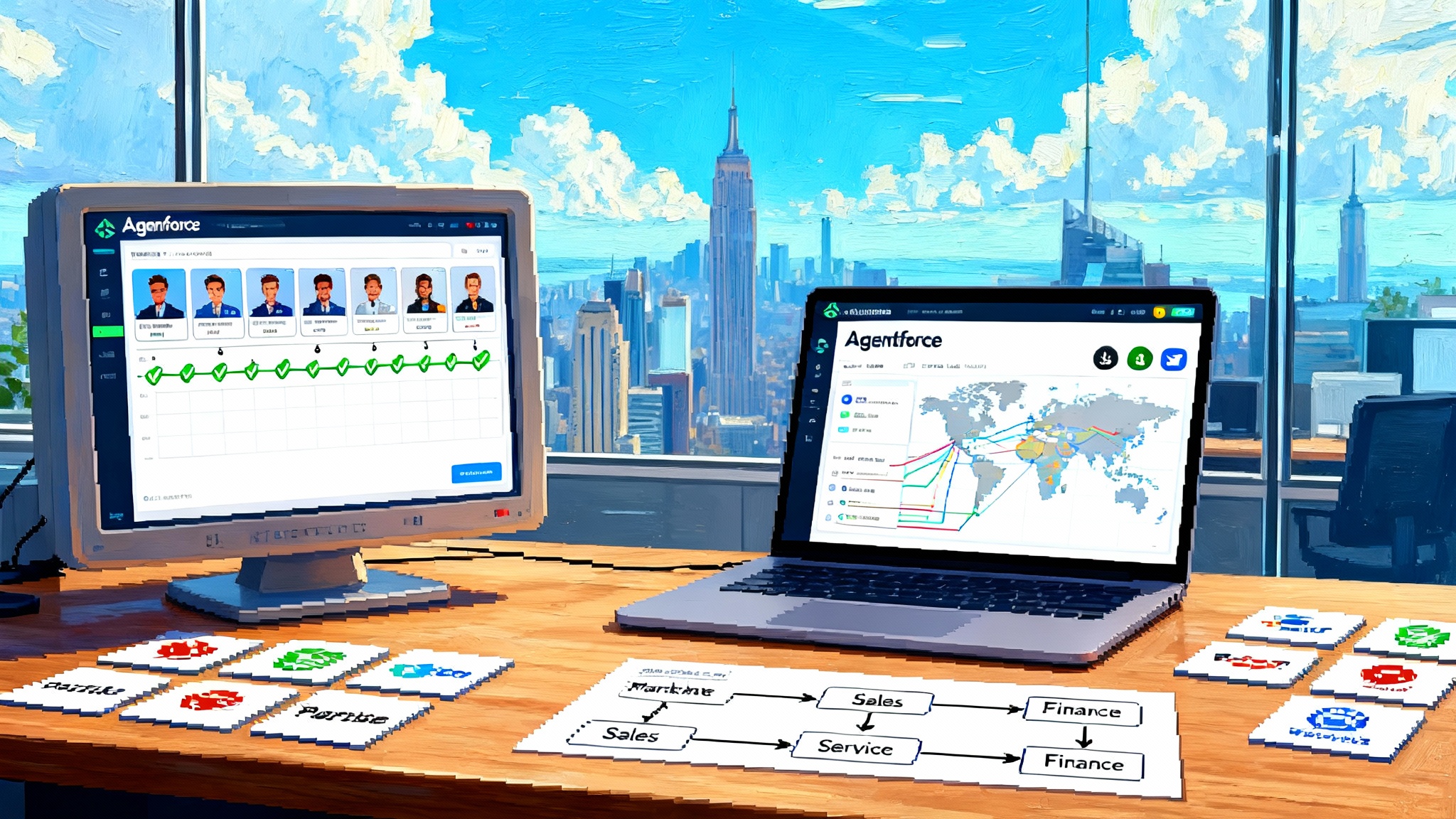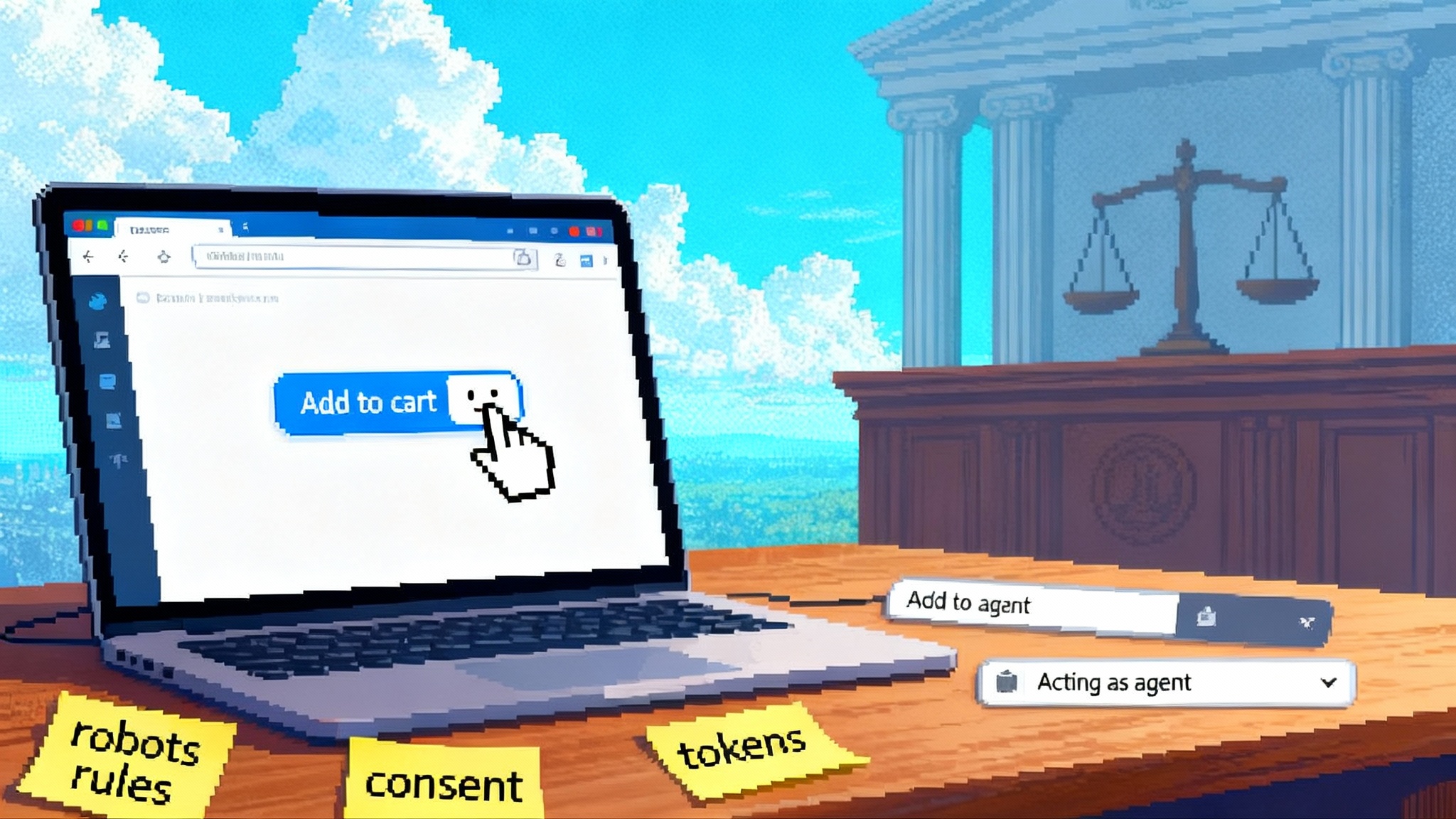Agentforce 360 Makes Enterprise Agents Finally Real
Salesforce just moved enterprise agents from slideware to production with Agentforce 360. See how marketplace components, outcome pricing, resilient operations, and native entry points add up, plus a 90-day plan you can run.

The week agents stopped being a demo
On October 13, 2025, Salesforce shifted the enterprise AI conversation from promises to production. The company launched Agentforce 360 globally and expanded partnerships so customers can choose among leading model providers while meeting regulated-industry requirements. As Reuters framed it, the move puts agents, humans, and data on a single platform with real outcomes instead of prototypes. You can see the coverage in Reuters on the global launch.
If you are a CIO, COO, or VP of Operations who has been living on slide decks and sandboxes, Agentforce 360 is the first credible path to an agentic enterprise you can buy, deploy, and hold accountable. Four pieces make the difference: a marketplace that ships capabilities on day one, pricing that aligns to outcomes, resilient operations built for the messy real world, and entry points that meet people inside the tools they already use.
The four pieces that finally make agents production ready
1) A marketplace that ships capabilities on day one
Think of AppExchange as the original enterprise app store. AgentExchange is its agent-native sibling. Instead of apps alone, it carries the building blocks that make agents useful in the enterprise: prebuilt actions that call systems, topics that bundle intent with policy, and full templates for common jobs like triaging a support case or chasing a renewal. Partners ship these components only after security review, so you are not stitching together code from a public repository. You are assembling trusted modules that fit your stack.
Why this matters: speed and repeatability. A retailer can import a returns agent that already knows how to pull order details from Commerce Cloud, generate a return label, and update the ticket in Service Cloud. A bank can start with a compliant know-your-customer template and then add firm-specific checks through low-code steps. The marketplace lets you avoid reinventing the common 80 percent of patterns every company needs.
This marketplace-first posture also pairs well with broader operational patterns we have seen across the industry. If you want a deeper view on how teams standardize agent components into repeatable pipelines, our analysis of the Agent Bricks production pipeline shows how atomic building blocks accelerate delivery while keeping governance intact.
2) Outcome-aligned pricing that forces hard ROI
Most AI pricing is a guessing game. Seat licenses in one place, tokens in another, and a surprise bill when usage spikes. Agentforce introduces Flex Credits, which flips the frame. You purchase a pool of credits, and the platform deducts credits when an agent completes a real action you care about. Examples include updating a record, resolving a case, drafting and sending an approved email, or closing out an expense.
This is not just friendlier finance. It is governance by design. If you are paying per action, you will define what counts as success, log it in a consistent way, and instrument every step. That discipline produces a clean return on investment story: cost per successful action versus the value of that action. Finance leaders can compare agent actions to human handling time and make clear decisions about where to expand.
3) Resilient operations for a world where models fail and facts change
Production systems must survive reality. Agentforce’s most consequential upgrades are operational, not flashy: multi-model failover, answers grounded in up-to-date sources, and a trust posture suitable for public sector work.
- Multi-model failover: If one provider’s model degrades or goes dark, Agentforce can route traffic to an equivalent model from an alternate provider and recover without human intervention. That turns model volatility into a short blip instead of a service outage.
- Web-grounded answers: Agents can cite and reason over current external sources in addition to internal knowledge, which reduces hallucinations and keeps answers fresh when policies, prices, or regulations change by the hour.
- Public sector grade compliance: Agentforce is available in Salesforce Government Cloud Plus with FedRAMP High authorization, which opens a path for agencies and contractors that require elevated assurances.
Salesforce packaged these changes in its summer platform upgrade, which brought lower latency, inline citations, and automatic model failover, and made the government authorization explicit. The intent is simple: the platform should deliver consistent answers and actions even when the upstream AI world is noisy. Salesforce details the upgrade in Salesforce on Agentforce 3 resiliency.
For leaders thinking about runtime discipline, this emphasis on operational resilience is part of a broader trend. You will find similar concerns in our look at the AWS AgentCore enterprise runtime, where observability and policy-first execution turn agent experiments into dependable services.
4) Native entry points in Slack and Google Workspace
Agents are least useful when they force people to tab-switch. Agentforce 360 meets users in Slack and Google Workspace. A seller can ask an agent in Slack to summarize a week of account activity, generate a follow-up in the right voice, and file the notes back to the opportunity record without leaving the chat. A support leader can schedule a Gmail message that bundles an investigation summary and a refund, then log the action and the refund code in Service Cloud. The work happens where people already spend their time, which is the fastest way to change behavior and adoption curves.
What this unlocks next
When these four pieces snap together, enterprise agents stop being isolated chatbots. Three new capabilities move to the foreground.
Cross-app A2A workflows
A2A means agent to agent. It is what happens when one agent can securely call another, share context, and hand off ownership. Imagine a procurement agent that needs a vendor task performed. It calls a finance agent to confirm budget, then a security agent to check the vendor’s posture, then a Google Sheets agent to update the purchase order. The primary agent remains the single face to the user while specialist agents execute in the background with traceable actions.
The practical value is elimination of the whisper game. No more copying data between systems or pasting stale screenshots into chats. You get a clean execution graph and a log of who did what, when, and why. If you want to see how A2A is evolving across the industry, our deep dive on Vertex AI Agent Engine A2A uncovers how orchestration and code execution make these handoffs robust.
Hybrid reasoning across Gemini, OpenAI, and Anthropic
Different model families have different strengths. Gemini handles multimodal understanding and long context well. OpenAI’s frontier models are flexible and creative. Anthropic’s Claude models are often preferred in sensitive environments. Agentforce’s reasoning engine can orchestrate across providers so that the best tool tackles each step while your policy, audit, and logging stay consistent. The point is not model shopping. The point is outcome shopping with policy that follows you.
Observability that helps you tune instead of guess
The Command Center in Agentforce gives you the equivalent of a flight data recorder for agents. Leaders can see how often actions succeed, where plans get stuck, what content gets cited, and which model changes affected latency or quality. That observability is the raw material you need to set targets and to answer the board’s simplest question: is this worth it.
A 90-day playbook to pilot, prove ROI, and scale in 2026
You can turn the launch energy of October into measurable outcomes by the end of the quarter. Here is a pragmatic plan that teams can use to move from slideware to live service.
Days 0 to 30: Choose one job and instrument it fully
- Pick a narrow, repetitive job with access to clean data. Examples: password resets with device checks, returns with refund routing, sales follow-ups after a demo, contract summarization for renewals.
- Define a single success action in unambiguous terms. For a return it might be: label issued, case closed, refund code written back to the order record.
- Establish baselines. Measure current handle time, containment rate, and cost per action with humans. Capture variance, not just averages.
- Configure the trust boundary. Connect only the required systems. Lock agent permissions to least privilege. Route through enterprise identity and logging.
- Select components from AgentExchange. Favor templates with published policies and audit trails. Avoid custom code until you have a working baseline.
- Set the measurement contract. Every agent attempt writes a structured log with plan, tools used, grounding sources, success or failure, and human-in-the-loop touches.
Output at day 30: a working agent that performs one job, with clean logs, and a dashboard that shows time, quality, and cost versus the human baseline.
Days 31 to 60: Harden for production and prove value
- Close the loop on grounding. Ensure every answer that cites external sources links to an approved list. Reject responses with missing or untrusted citations.
- Turn on multi-model failover. Simulate provider outages and show that service stays up. Document the decision tree and the rollback procedure.
- Calibrate the planner. Run targeted red teaming to provoke bad plans, then add guardrails and policy tests. Keep a library of failure prompts and replay them after every change.
- Move from chat to action. Expand beyond answers to actions that change records and trigger flows. Require an explicit approval step for the first week, then remove it as confidence grows.
- Get finance on the dashboard. Track Flex Credit consumption per successful action. Compare to human cost and to the value of the action for a clear return on investment line.
Output at day 60: an agent that handles a meaningful fraction of a single job without handholding, documented rollback, and a preliminary return on investment curve that finance and operations agree on.
Days 61 to 90: Scale sensibly and prepare the 2026 plan
- Add two more actions that touch different systems. For example, have the returns agent also process exchanges, and have it trigger proactive outreach when a shipment stalls.
- Introduce A2A. Let your primary agent delegate a subtask to a specialist agent, then reconcile the result. Keep the single-face interaction pattern for the user.
- Push entry points into Slack and Gmail. Give users a pinned message or a simple slash command to summon the agent with the right context. Measure adoption and satisfaction.
- Establish runbooks and service level agreements. Declare what up means, how you page an owner, and how you hand cases back to humans.
- Lock in governance. Define change windows, a sign-off process for new actions, and a quarterly review of citations, prompts, and model choices.
Output at day 90: a small portfolio of agent actions that work end to end, a believable return on investment, and a plan to extend to two new departments in the new year.
What to measure, and why
- Action success rate: the percentage of attempts that complete the defined action. This is your single most important metric.
- Time to resolution: seconds from request to completed action, compared to the human baseline.
- Grounding coverage: the percentage of answers with approved citations or internal sources. Low coverage signals risk.
- Containment rate: the share of requests that never needed a human. Use this to plan staffing.
- Cost per successful action: Flex Credits consumed per completed action, converted to dollars, not per attempt. Tie this to value per action.
- Failover rate and impact: how often the platform had to route around a model issue and what it cost you in latency or accuracy.
- Human trust: a lightweight survey in Slack after each interaction. You want confidence, not just speed.
Common pitfalls and how to avoid them
- Trying to automate the entire job at once: Start with the smallest valuable action. Use clean baselines so you can show progress.
- Building from scratch: Resist custom code until you have exhausted marketplace components. You want velocity and standardization early.
- Ignoring finance and operations: You need finance to validate value and operations to keep the lights on. Put them on the steering group from day one.
- Skipping failure drills: Run tabletop exercises for model degradation, permission errors, and grounding outages. Test the runbooks, not just the happy path.
- Over-permissioned agents: Least privilege is your friend. Escalate rights only when the logs prove the need.
How Agentforce 360 fits the broader enterprise stack
Agentforce will live alongside customer data platforms, integration layers, and analytics suites. The healthiest implementations treat agents like new team members. They get identity, permissions, observability, and performance targets. They are onboarded with access to only what they need. Their actions are logged with plans and citations. And their performance is reviewed just like a human’s.
This is also where the industry is converging. Agent runtimes are becoming first-class parts of the stack. If you want a sense of what that looks like in practice, the AWS AgentCore enterprise runtime comparison shows how policy, tooling, and observability converge to make agents boring in the best possible way.
What this means for 2026
With Agentforce 360 live and the core pieces in place, 2026 will be about scale with control. Procurement teams will ask marketplaces to include agent components with clear support terms. Security reviews will move from abstract risk to concrete policy checks on grounding lists and tool permissions. Integration teams will treat agents like new employees who need onboarding, access, and performance reviews. And executives will ask a simple question each quarter: which actions did agents perform, how much did those actions cost, what did we save, and what did we learn.
Above all, the center of gravity shifts from writing prompts to designing work. Which actions matter. Which policies define success. Which systems should an agent touch. The agentic enterprise is no longer an idea. It is a system you can run, observe, and improve.
The bottom line
Agentforce 360 makes enterprise agents feel like software you can count on. The marketplace gives you a head start, outcome pricing forces you to measure value, resilient operations keep the lights on, and entry points in Slack and Google Workspace drive adoption. Hybrid reasoning across Gemini, OpenAI, and Anthropic opens choice without chaos. If you want agents that close tickets, update records, and send accountable emails, the pieces are in the box. Choose the right first job, measure it honestly, and scale what proves itself.








